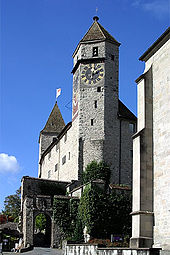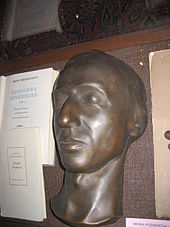Poland Museum Rapperswil
The Poland Museum Rapperswil is located in Rapperswil Castle from the 13th century in Rapperswil . It looks back on over 140 years of tradition. The history of the Poland Museum spans three periods (1870–1927, 1936–1952 and 1975 to the present day) during which it existed in various forms, depending on the political situation in Poland .
The Poles in Rapperswil
The first step was marked by the refugees of the November uprising of 1830 and the January uprising of 1863 against Russian rule in Congress Poland . They ended up in Switzerland, among other places, where the Swiss Central Committee for Poland was established in 1863 with the help of the Zurich writer and poet Gottfried Keller . This worked closely with Count Władysław Plater , who had fled to Switzerland and lived in Rapperswil . The “Polish Freedom Column”, which was built in 1868 and now stands in front of the Rapperswil Castle, and the first Polish National Museum, which opened two years later, go back to Plater.
Polish National Museum (1870-1927)

In the museum established by Graf Plater in Rapperswil Castle in 1870, the rooms of the castle were soon filled with gifts (works of art, militaria, documents, book collections) from Poles and friends of Poland from all over the world. Until the rebirth of Poland in 1918, the city of Rapperswil was a refuge for Polish hopes, encounters and ideas. Since 1895 the urn with the heart of the Polish and American hero Tadeusz Kościuszko, who died in Switzerland, has been kept in the mausoleum set up for this purpose in the tower .
After the 'rebirth of Poland' ( Second Polish Republic from November 1918), the collections of the Poland Museum left in 1927 according to the will of Count Platter Rapperswil for Poland. 3,000 works of art, 2,000 historical souvenirs and militaria, 20,000 engravings, 9,000 medals and coins, around 92,000 books and 27,000 archive items filled hundreds of boxes in 13 wagons. The urn with Kościuszko's heart was also transferred to Warsaw . The majority of the Rapperswil collection, mostly archives and books, was destroyed during the destruction of Warsaw in World War II .
Museum of Contemporary Poland (1937–1951)
In 1936 an exhibition of contemporary Polish art was organized in the vacant Rapperswil Castle thanks to the initiative of the artist group “Blok”. In the years that followed, under the protectorate of the Polish Ministry of Foreign Affairs, a permanent exhibition was created showing the artistic and economic achievements of the newly established Poland. The exhibition now appears under the title "Museum of Contemporary Poland". Ms. Halina Jastrzębowska-Kenar was appointed as custodian.
In June 1940, after fighting against the Wehrmacht in France, 13,000 Polish soldiers of the 2nd Rifle Division were interned in Switzerland . The Poland Museum with its library took over the cultural and educational care of the internees.
Even if the Confederation recognized the communist government in Warsaw in 1945, the local community of Rapperswil opposed the redesign of the Poland Museum in the course of the Cold War and canceled the lease for the castle. The collections were transported to Poland in 1952. The castle was taken over by the Swiss Castle Association . As part of the restoration of the building, almost all Polish traces on the castle were removed.
In response to the closure of the Poland Museum in 1954, well-known Swiss and Polish emigrants founded the anti-communist- oriented association of "Friends of the Poland Museum Rapperswil". On the initiative of the association, a Poland museum was opened in Rapperswil Castle for the third time in 1975.
Poland Museum Rapperswil (since 1975)
Janusz Morkowski was appointed curator of the Polish Museum. The museum was financially supported by Julian Godlewski from Lugano and from the Swiss side by the cantonal and city councilor Hans Rathgeb, who was later elected chairman of the Association of Friends of the Polish Museum.
The newly created museum and the events organized there became the epitome of free and independent Poland for Poles at home and in exile. Over the next 25 years, the museum was visited by over 300,000 guests.
The initially modest collections of the Poland Museum grew steadily in number and quality thanks to the gifts of Polish emigrants and friends of Poland.
The current exhibition in the Poland Museum is structured according to themes. In a tour sequence are shown:
The Swiss in Poland, the great waves of Poles emigrating to the West (after uprisings, war events and persecutions), the Poles in Switzerland (engineers, scientists, artists and soldiers), well-known personalities (e.g. Nicolaus Copernicus , Frédéric Chopin , Madame Curie , winner of the Nobel Prize for Literature), the Poles' struggle for freedom and faith ( relief of Vienna in 1683; national uprisings in 1830 and 1863; World War II and internment of the 2nd Polish Rifle Division in Switzerland; John Paul II , 1970 and Solidarność Movement 1980).
Further topics in the Poland Museum are: Polish painting of the 19th and 20th centuries, handicrafts (including Sarmatian art of the Polish nobility in the 18th century), evidence of Jewish culture in Poland , as well as Polish sacred and folk art. In the framework of the exposition you can see pictures by Chełmoński , Brandt , Wyczółkowski and Boznańska , as well as miniature paintings by Vinzent Lesseur around 1800 - a gift from the Count Tarnowski family.
Old book printing, chronicles and maps of Poland are also on display, most of them from the estate of Roman Umiastowski . The watches from the Patek manufacture in Geneva or the tobacco boxes with motifs of Polish Uhlans during the Napoleonic wars, as well as a collection of gems with portraits of politicians and the military from the 19th century from the old “Plater Museum” are also valuable .
The folklore room is particularly popular with its folk costumes , reverse glass paintings and carvings by folk artists, such as the collection of almost 500 sculptures by over 80 folk artists. The battlements and the five-storey defense tower with frequent changing exhibitions conclude the exhibition.
The Poland Museum is testimony to a long friendship between the Polish and Swiss. From 1870 onwards, the Polish tenants played a key role in saving Rapperswil Castle from collapse. During the renovation work from 1988 to 1990, they contributed to the renovation costs of the museum premises. In 2008, over 9,000 people from 30 countries petitioned for the preservation of this traditional and symbolic museum in Rapperswil Castle. On October 11, 2012, a free newspaper launched a campaign against the renewal of the rental agreement between the Polish Museum and the local community of Rapperswil as the owner of the castle.
Library and archive
The library and archive of the Poland Museum have been located in the "Burghof" building on Rapperswil's main square since 1987. The library specializes in subjects presented in the Poland Museum. It also contains translations of Polish literature into Western languages, a few hundred old Polish prints and an important collection of old maps dealing with Poland.
The archive contains documents concerning Poland in Switzerland and Swiss-Polish connections; so z. B. the internment of the 2nd Polish Rifle Division in Switzerland 1940–1945.
In the library there is a permanent exhibition of the collections of Jadwiga and Jan Nowak-Jeziorański , the former director of the Polish department of Radio Free Europe in Munich, as well as documents, book collections and pictures of the Romer family from Cytowiany in Lithuania .
Poland Museum activities

The activities of the Poland Museum are supplemented by numerous temporary exhibitions, concerts with Polish music and lectures relating to Swiss-Polish topics. The museum (informally) plays the role of a multifaceted institution that propagates knowledge about Poland and Polish culture.
Today's Poland Museum was created and will continue to be run thanks to the voluntary commitment of many employees. It does not have permanent employees and operates without government subsidies. The organization and administrator of the Poland Museum is the “Association of Friends of the Polish Museum”, founded in 1954 by Polish emigrants and Swiss friends, which has been supported by the Polish Cultural Foundation Libertas Rapperswil since 1978. Since the fall of the Wall in Poland in 1989, the association has received professional support from well-known Polish museums and libraries in the design of exhibitions and numerous other cultural activities. Anna Buchmann has been the curator since 2005.
Future of the Polish Museum
The city of Rapperswil-Jona intends to rebuild the castle and set up a new castle museum, which will also take up the topic of “Poland in the castle”. Today's independent Poland Museum is to be closed. The Polish ambassador to Switzerland, Jakub Kumoch , is committed to the museum in the castle and declared in 2018 that "for us Poles a small Rütli is". The Swiss Federal President for 2019, Ueli Maurer , said at a state reception in Poland "The municipality of Rapperswil has not yet fully recognized the importance of this museum for Poland and Switzerland" and that he wanted to work for a compromise between Rapperswil and the State of Poland.
literature
- Anton Krenn: The Poland Museum in Rapperswil. In: Schweizer Illustrierte , Vol. 7, 1903, pp. 155–157. ( e-periodica )
See also
- Poland routes in Switzerland
Web links
- Website of the Poland Museum in Rapperswil
- The Polish Museum in Rapperswil at Google Cultural Institute
- City administration Rapperswil-Jona: Poland Museum in Rapperswil Castle
Individual evidence
- ↑ Polish Museum: Collection of signatures for the whereabouts of the Poland Museum in Rapperswil Castle in 2008 (PDF; 28 kB)
- ↑ Pro Schloss Rapperswil: History and significance of the Polish Museum ( page no longer available , search in web archives ) Info: The link was automatically marked as defective. Please check the link according to the instructions and then remove this notice.
- ^ OM: "Poland in the Castle" instead of the Poland Museum . In: Linth 24 . August 13, 2019. Retrieved November 22, 2019.
- ^ A b Mario Aldrovandi: Federal Councilor Maurer interferes in the Poland Museum . In: Linth 24 . May 2019. Retrieved November 22, 2019.
- ↑ Pascal Büsser: "The Poland Museum in the castle is a little Rütli for us" . In: Southeastern Switzerland . June 22, 2018. Retrieved November 22, 2019.
Coordinates: 47 ° 13 ′ 36 " N , 8 ° 49 ′ 6" E ; CH1903: seven hundred and four thousand four hundred and eighty-seven / 231556


